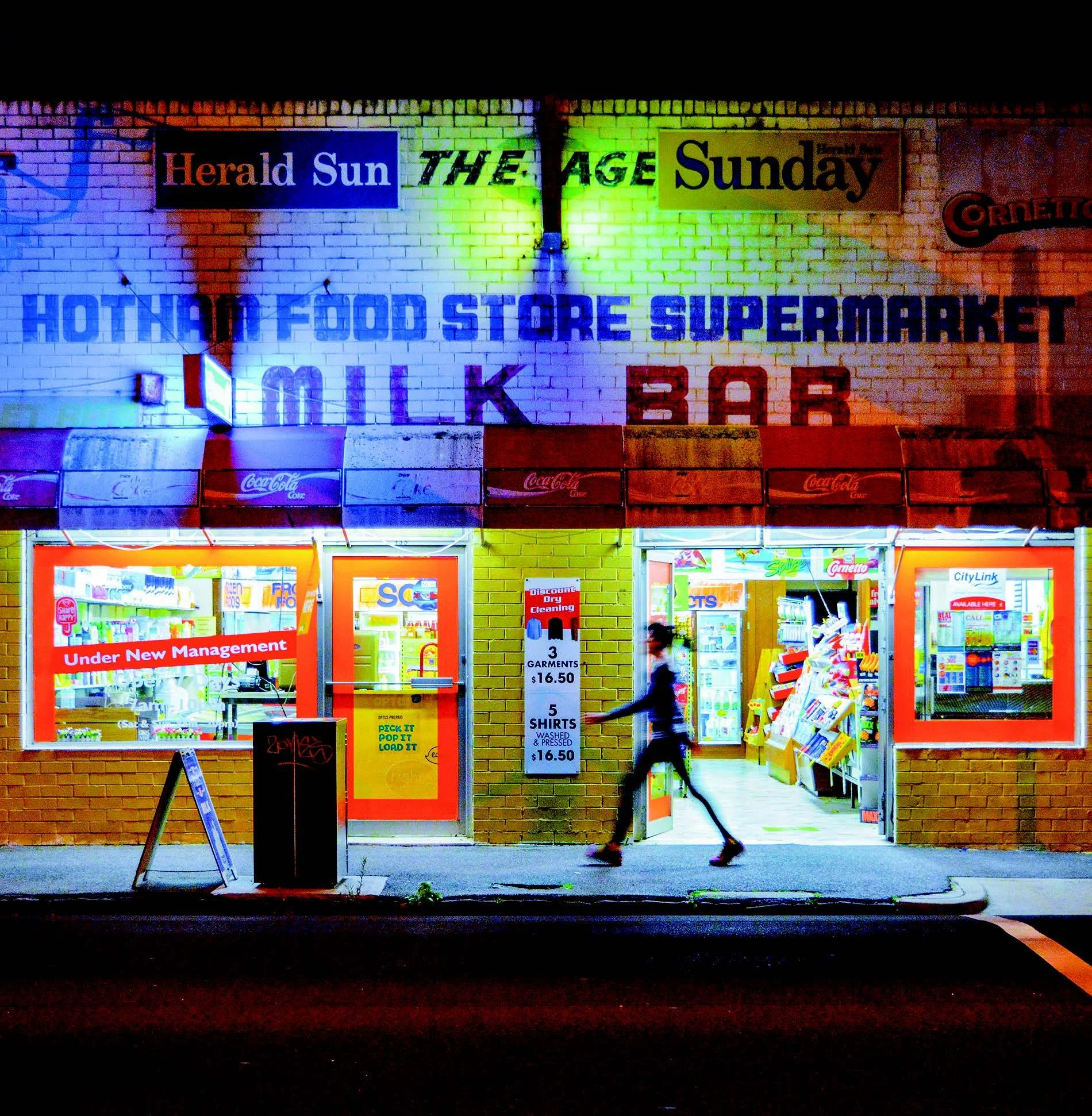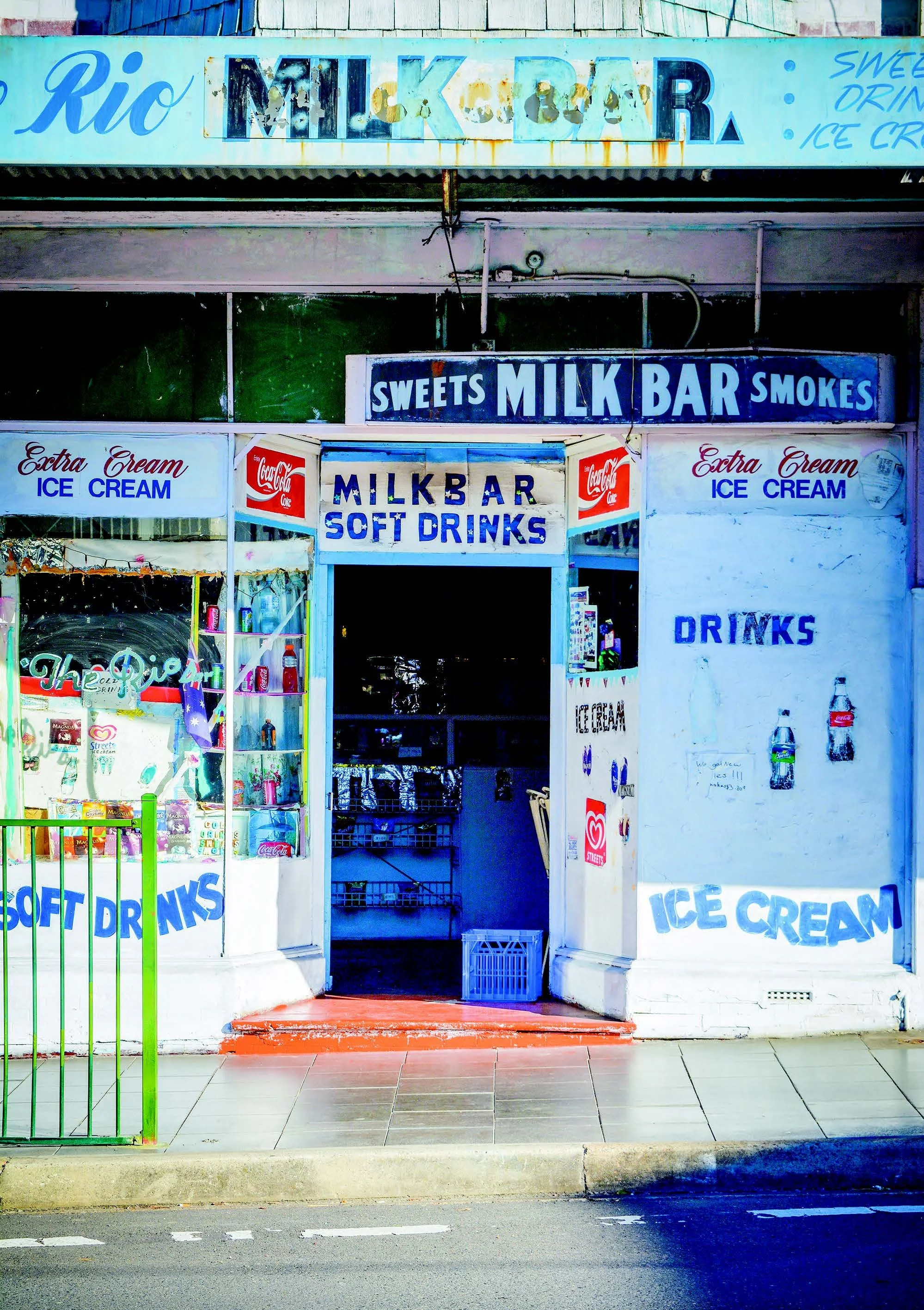REINVENTING A CLASSIC
Eamon Donnelly, ‘Hotham Street Nights’ © milkbarsbook.com
WORDS BY OLIVIA MORFFEW
Once ubiquitous on street corners all across Melbourne, the humble local milk bar fell prey to supermarkets, rising rent and changing social climates. But are we seeing a contemporary revival of this old classic?
Milk bars were once a staple in Melbourne suburbia. If you ask anyone who grew up in Footscray or Brunswick before the 1990s, chances are they have a story of popping down to the local milk bar to buy milk or bread for the family. That was in a time before 7-Elevens occupied every corner in major suburbs, before Woolworths and Coles grew and took over the small, independent stores. Driving through Brunswick and seeing the husks of milk bars, their walls marked with graffiti and the windows covered with yellowing newspaper spreads evokes memories of another time.
When the first milk bars were introduced to Australia in the 1930s they operated as diners, serving up American food and drink. This was before they became the convenience stores that they’re commonly known as. Back then milk bars were founded by migrant families looking for a fresh start in a young country.
Flash forward to the 1960s and over 4000 milk bars had been established throughout Australia. There were still some American-style milk bars from the 1930s, but the term ‘milk bar’ was now synonymous with corner store, the kind of place where you could get paper bags of lollies, milkshakes and the daily newspaper. They were social hubs where people from all backgrounds and identities mingled with one another. For Nonna—my Italian grandmother who migrated to Australia in the 1960s—a humble milk bar in Glenferrie was where she met her husband.
After bumping into each other at the milk bar for a few days back to back, Nonno finally made his move. He offered to buy my Nonna a bottle of water. He then asked if she had a boyfriend. ‘No I haven’t got a boyfriend,’ Nonna replied.
The rest is almost history. They eventually married and moved to Brunswick, where milk bars became an integral part of their lives. When I sat down with Nonna to talk about this part of her life, she recalled how ‘everyday, even when I come back home [from work], if I needed something, I buy. There was two [milk bars]—one on both corners.’
Milk bars played an essential role in society. ‘Everyone run in the night and go to the milk bar and buy the bread, buy the milk [and] go home.’ It was a simple way of living. These local convenience stores were accessible to Australian families regardless of class and race. When I asked her if there were American diner-style milk bars from the 1930s, she replied, ‘[there were] no cafes, nothing. You have to go to the city if you want or Carlton. You can’t see cafes around like now.’
These popular establishments housed many memories for Melbourne residents, often becoming the rite of passage for children making their first transaction—normally a packet of lollies for under a dollar. In Nonna’s case, it was where she socialised with other workers from different occupations every day, five days a week. It was a place for her to mingle with other Italians and get to know those who were like her—migrants looking for a fresh start.
But as the fashion, technology and social climate changed with the times, milk bars didn’t. Or rather, couldn’t. Throughout the 1970s and 1980s, these popular corner stores were slowly pushed out of inner-city suburbs. Politics played a major role in the slow decline of the humble milk bar. During this time, Australian laws banned milk bars and food shops from remaining open on Saturday afternoons or Sundays. This was during a time where petrol stations couldn’t sell consumable goods, making milk bars the only place to get groceries on the weekend. As these laws started changing, so did the supermarket landscape. By 1973 supermarket giants Coles and Woolworths had stores in every capital city, with both companies expanding and capitalising on the changing social climate.
I asked Nonna what she thought contributed to the decline of milk bars in Melbourne. She replied, ‘now all the big shops kill the little shops and I feel sorry for people. That’s the main reason why [there aren’t any milk bars left].’
Come the 1990s, milk bars were well and truly on the decline. With supermarkets popping up left, right and centre, milk bars were being neglected in favour of these bright new places. Australia was also going through a recession which saw businesses under pressure from high interest rates affecting not only milk bars but most family-owned and independent businesses. Richard Cardillo, ex-owner of a milk bar and adjoining family pizza shop in Seddon, explains that ‘you were just surviving, eventually you were lucky if you broke even each week.
Despite the closing down of many small businesses his milk bar was still a small community. ‘It was one-on-one customer service—you knew everyone by name,’ Richard says. ‘My regulars came each day, they were loyal, instead of going to the supermarket.’
But due to the poor financial climate of the 1990s Richard’s milk bar eventually closed, only to be bought and repurposed into a Thai restaurant. Richard described the new owners as not having ‘the vision of keeping it as a milk bar, they bought the building rather than the business, they purchased it for the location.’ The restaurant is still going strong, but as Richard notes, ‘it was disappointing to see the business change, I raised my whole family there.’
When asked about what contributed to the closing down of so many milk bars, Richard was clear. ‘Supermarkets—eventually they run you out of business [and] there’s just no way to compete with them. I could go to Coles and buy a slab of Coke for a cheaper price than I could buy it from the wholesaler and still save ten dollars per slab.’
Throughout the 1990s and 2000s car culture in Australia grew, as did the influx of petrol stations. Caltex, 7-Eleven and other petrol stations started selling consumable goods as well as other products, acting as petrol stations and corner stores throughout Melbourne. These new places appealed to many Australians—convenient locations where you could pull over, fill up your car and buy that one thing you ran out of earlier that morning. On top of this, there was the appeal of driving to the supermarket to collect your groceries rather than walking down to the local milk bar.
Jump to the 2010s and most milk bars have become derelict and abandoned. The empty ones are canvases for graffiti artists, but the few that are still in business have faded advertisements plastered on their windows and the iconic plastic flaps that double as a door. But like the scenario with the Thai restaurant, more and more milk bars are being bought and repurposed into trendy cafes.
These cafes are an addition to Melbourne’s distinguished food culture, providing a nostalgic flair for those stopping for a bite to eat or a morning coffee. These cafes are a twenty-first century variation on a classic.
‘These popular establishments housed many memories for Melburnians, often becoming the right of passage for children making their first transaction.’
Maybe they even provide a window for millennials and Gen Z kids to experience what their parents and grandparents grew up with.
My local milk bar in Essendon underwent a renovation in July. It now doubles as a cafe and a food store—there’s a wall of bagged lollies with everything from Blueberry Clouds to Coke Bottles, offering customers a sweet throwback. A retro Coke-themed clock rests on the space above the fridge, one of the many homages to milk bars from the 1930s. Mums are grabbing coffee and cake for a morning treat while their kids beg them for a bag of lollies for the walk home. The reinvented and modern milk bars, with their elaborate coffee machines and vintage furnishings, are paving the way for reviving the popularity of these local stores.
It’s like the 1960s all over again—instead of running around during the night to pick up a loaf of bread, we’re running around during the day to get a gourmet toasted sandwich.
Eamon Donnelly ‘The Rio’ image © milkbarsbook.com
MELBOURNE’S MILK BAR CAFES
HOFFMAN’S ROAD MILK BAR
75 Hoffman’s Road, Niddrie, 3042
Hoffman’s Road Milk Bar holds the charm of the old milk bars that locals grew up with, but with a modern flair. Think brightly lit interior, gourmet toasties and addictive coffee. There’s an entire wall of sweets and shelves stocked with food for you take home.
ROWENA CORNER STORE
44 Rowena Parade, Richmond, 3121
The ultimate throwback to the swinging 1960s, with vinyl booths and Elvis playing through the speakers, Rowena Corner Store will make your morning brunch that little bit fancier. There are tubs of homemade lollies, plus an entire menu dedicated to milkshakes. This little cafe pays homage to the original milk bar cafe that kicked off the craze.
MOORE ST MILKBAR
38 Moore Street, Footscray, 3011
You could walk right past Moore St Milkbar and assume it was just another run-down old store. It isn’t. You can enjoy your coffee, people watch and pick up a few groceries you might’ve missed during the week.
JERRY’S MILK BAR
345 Barkly Street, Elwood, 3184
Jerry’s has everything from a gumball machine for kids to those realistic rubber spiders for the kids at heart. The heritage-listed building adds a certain charm to Elwood. The original signage still hangs out the front of the cafe and 1950s furniture fills up every inch of the interior.
FORDHAM’S MILK BAR
116 Fordham Avenue, Camberwell, 3124
A gourmet grocery store and a trendy cafe rolled into one. If that doesn’t scream Melbourne, then I don’t know what does. Fordham’s stocks everything from pantry staples to fridge essentials. Don’t forget to treat yourself to the glamourous menu after your weekly shop.


